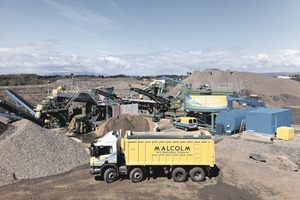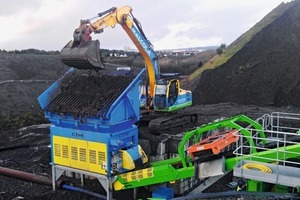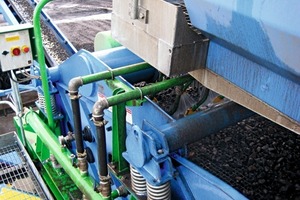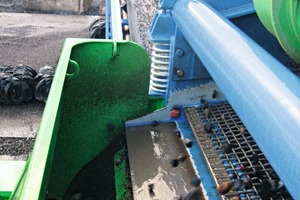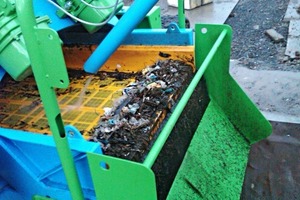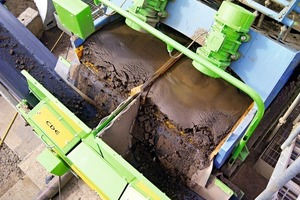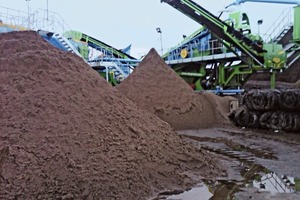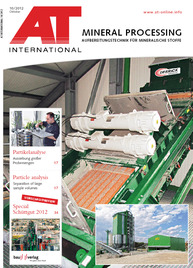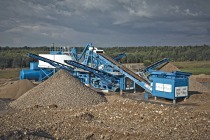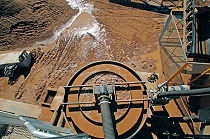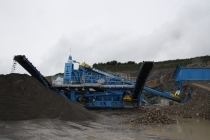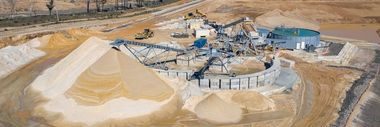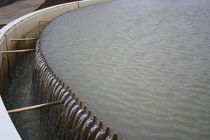Rubble washing
Malcolm Construction hosted a three day event from 03.- 05.07.2012 at their Shewalton Quarry & Waste Management facility in Irvine on the west coast of Scotland (Fig. 1). Visitors had the opportunity to inspect the new C&D waste recycling plant from CDE Global accompanied by members of the CDE team. Malcolm Construction had also a team of people available to answer questions on their experience with the new plant.
The washing plant includes an M2500 E4R mobile aggregate and sand washing system, AggMax 83R portable logwasher, aggregate screening and trash removal plant and a water management and recycling system, the AquaCycle A400. The plant is being used to process a variety of wastes including arisings from Malcolm Construction public works contracts and construction, demolition and excavation waste received at the landfill sites operated by the company. The processing of this material results in a recycled sand product with application in concrete and a clean recycled aggregate. “There has been significant interest in the recycled concrete sand from some of the major players in the Scottish construction materials market”, explains David Balmer, Environmental Manager with Malcolm Construction. “The recycled aggregates have shown significant quality improvements from dry processed material thanks to the removal of lightweight contaminants by the Aggmax.”
Material is first delivered to the M2500 and an overband magnet on the feed conveyor removes any ferrous material which is subsequently discharged to a skip (Fig. 2). A wash box at the head of the feed conveyor fluidises the material before it is delivered to the integrated ProGrade P275 double deck rinsing screen (Fig. 3). The 5 x 1.5 m screen is fitted with wire mesh on the top deck with a 40 mm aperture which delivers the 40 mm material to the oversize stockpile via one of the four integrated 9 m stockpile conveyors. This material is then crushed before being sent back to the M2500 for further classification.
One of the major benefits of the ProGrade screen is the independent washing system which ensures it is entirely separated from the vibration of the screen minimising the risk of plant failure. The lower deck of the ProGrade screen is fitted with polyurethane screen media (5 mm aperture) and the 5-40 mm material is then sent to the AggMax 83R (Fig. 4). This unit integrates several processing phases including attrition, trash removal, dewatering and sizing of the clean recycled aggregate.
As material enters the integrated RotoMax RX80R logwasher attrition is applied through synchronised rotation of the dual shafts which are fitted with highly wear resistant high cast chrome paddles mounted in a fan arrangement. This arrangement not only ensures that the material in the RotoMax is subject to the highest level of attrition but also eliminates shock loading on the bearings thus reducing plant maintenance requirements. Efficient synchronisation of the dual shafts is achieved by the drive mechanism with a single motor and gearbox. As the recycled aggregate moves through the RotoMax the liberated fines, waste water and lightweight contaminants are floated off at the rear and delivered to a trash screen (Fig. 5). Efficiency at this stage is maintained through the steep waste discharge chutes which eliminate the risk of blockages by the recovered sand product. The trash screen allows for the liberated fines to be sent to the sand washing phase while the lightweight contaminants are discharged into a bay.
Once the aggregates have progressed through the RotoMax logwasher they are discharged to the dewatering and sizing phase. In this instance a triple deck dewatering screen is employed to allow for the production of a 5-10 mm, 10-20 mm and >20 mm recycled aggregate which are sent to stockpile via three 15 m mobile conveyors. The configuration of this dewatering and sizing phase can be altered with the option of single deck, double deck or triple deck screen. The option chosen will depend on a variety of factors including the aggregate specifications required and existing equipment available on-site. “If there is an existing mobile dry sizing screen on-site this can be employed at this stage allowing for specification of the single deck dewatering screen on the AggMax”, explains Eunan Kelly, Regional Sales Manager in Scotland for CDE Global. “The advantage of the two or three deck screen is that it can save considerable space on site by removing the requirement for an additional dry sizing screen.”
The <5 mm material liberated from the 5-40 mm fraction is sent back to the EvoWash sand washing plant integrated on the M2500. This is combined with the <5 mm fraction from the initial screening phase which is delivered from the Prograde sump to the EvoWash dewatering screen which is split to allow production of two sands (Fig. 6). A 0-5 mm sand is dewatered and stockpiled (Fig. 7) while the 0-2 mm material is collected in the EvoWash sump and pumped to the hydrocyclone. The 63 µm fraction is removed along with the waste water via the cyclone overflow and is sent to the water treatment phase. Meanwhile the fine sand fraction is discharged via the cyclone underflow onto the second side of the split EvoWash screen before being dewatered and stockpiled.
Waste water containing the 63 µm material is sent from the EvoWash to the AquaCycle thickener by means of a gravity feed. This water recycling phase involves dosing the material with a flocculent which is prepared in the FlocStation poly plant. This is housed in an insulated 6 m cabin alongside the full wash plant control panel. The flocculent forces the fine particles to bind together and sink to the bottom of the AquaCycle tank where the settled sludge is conditioned by the quadrake mechanism. This ensures that the sludge density is optimised for discharge from the AquaCycle and allows the sludge to be pumped much greater distances than would otherwise be the case.
As the sludge settles, the recycled water overflows the weir at the perimeter of the AquaCycle tank and is then re-circulated around the washing plant which reduces the volume of fresh water required to feed the plant by 90 %. In this project, as on all C&D waste recycling plants which include an AquaCycle thickener, an additional lightweights removal screen is included over the AquaStore tank to ensure that lightweights such as polystyrene to not make it back into the water circuit preventing downstream issues with water pumps becoming blocked.
“Our investment in this new plant demonstrates our commitment to reduce the volume of waste going to landfill and to maximise the recycling and recovery of materials for re-use”, reinforced David Balmer at the end of the event.

